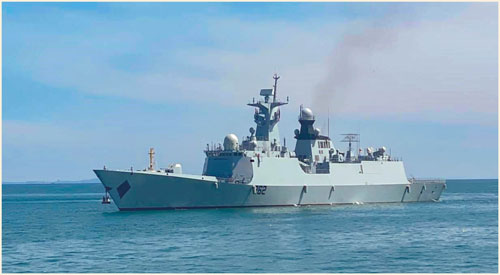Mansoor Bhatti
IN recent times, a significant increase has been observed in the types and intensity of maritime threats that our country is facing.
Pakistan’s reasonable response in support of struggling Kashmiris for their self-determination has increased the animosity with India. Moreover, the development of Gwadar port and the mega project, CPEC, have also extended the hostility with our eastern neighbor.
This has led Pakistan to further its maritime security interests including defence of coastline and freedom of navigation operations.
The other factor involved is the ambition of Indian Navy to enhance its maritime capability that Pakistan cannot afford to overlook.
The Indian Navy plans to increase the fleet of ships to 200 including an increase of 50 ships by 2027. This force level is being build up with the support of the US, Japan, Australia and other Western countries.
The important element in this is that our neighbor’s enhanced capability is likely to outnumber Pakistan rather than aiming at China because India knows that currently it cannot afford to confront China however, its capability can be used effectively against Pakistan.
In view of these increasing types and intensity of maritime threats, the Pakistan Navy has plans to enhance its operational capability by inducting new warships.
This upgrading is essentially defensive and aims to counter India’s hegemonic designs. To this end, the Pakistan Navy is stepping up to modernize its fleet in order to maintain a reasonable force at sea.
It has revised its development plans and is inducting new, technologically- advanced platforms in service. Previously, the Pakistan Navy had relied on the UK and the US for military equipment. In fact, these military platforms had provided a great impetus to the Pakistan Navy.
However, due to geopolitical shifts and the resultant defence partnerships with China and Turkey, the Pakistan Navy had committed to work on a comprehensive program to transform its naval platforms, especially destroyers and frigates.
The Pakistan Navy had been operating with 8 to 9 major surface ships which constrained the country’s capacity to increase its regional footprints and influence.
To redress this, a fleet size comprising more than 50 ships was envisioned by the Pakistan Navy. Under this, the Navy has recently acquired new platforms including the MILGEM Class Turkish Corvettes and Chinese 054 A/P frigates.
The recent induction of a new Chinese 054 A/P frigate platform known as Pakistan Navy Ship (PNS) TAIMUR is undoubtedly a milestone for the Navy. PNS TAIMUR is the second ship of its kind built at HZ Shipyard, Shanghai, China.
Two more ships of the same class will be commissioned by the end of next year. PNS TAIMUR is a technologically advanced and highly capable sea asset having hi-tech weapons and sensors, the latest combat management, and an electronic warfare system to fight under a multi-threat environment.
It is a multi-mission capable ship, fitted with potent weapons like Medium Range Surface to Air and Supersonic Surface to Surface Missiles, Guns, and Torpedo Defence Systems.
This Pakistan Navy’s Ship is a state-of-the-art platform which can perform variety of Maritime Operations including Anti Surface, Anti Air, Anti-Submarine and Maritime Security Operations.
These ships will provide sustainable boost to the combat capability of Pakistan Navy and enable to meet emerging challenges in the domain of maritime security and regional peace.
After the successful commissioning of the ship which was held in China, PNS TAIMUR participated in the exercise Sea Guardians-2022 along with Chinese Navy.
This Naval exercise between Pakistan and China is a manifestation of strong bilateral military relations which promotes safe and sustainable maritime environment in the region.
As part of overseas deployments, TAIMUR also visited various other countries including Cambodia, Malaysia, and Sri Lanka as part of goodwill visit.
To sum up, the induction of this platform proves that Pakistan is not oblivious to its defence needs. With the addition of these multi-faceted ships, the enemy, in spite of its numerical superiority, will find itself up against a formidable force.
Therefore, it is reasonable to argue that the Pakistan Navy is committed to developing a multi-dimensional response framework, with a view to meeting a number of threats and challenges at sea. Cognizant of the complicated threat-matrix, the command of the Pakistan Navy is really taking the force to a position where it can claim itself to be a responsible, robust, navy.
Strengthening the Pakistan Navy is critical to successfully navigating a plethora of challenges that an Indian Ocean marked by militarization and great-power politics brings to the table. Also, with Pakistan committed to regional connectivity and integration, a strong at-sea defense is necessary for the country.










